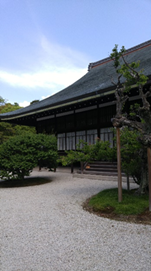Gravity(Attraction) of Kyoto 17 Prayers at the Imperial Palace for a Thousand Years
Yoshie Doi

Photo taken on May 23, 2020
At the Kyoto Imperial Palace tour
In the middle of Kyoto City stands Kyoto Gyoen National Garden, which is covered with gravel rather than concrete. When we enter the garden, we can feel the aura of the prayers of successive emperors for the safety and peace of the nation and the happiness of the people, as a memory of the land, even to us today.
The Gosho refers to the former Imperial Palace within the Tsukiji wall within the Gyoen. The Gyoen refers to the entire grounds including the Gosho, which is the residence of the Emperor, and is still the staying residence of the Emperor and Empress. The aristocratic town that surrounded the Gosho is now open to the public as a national park. It is open 24 hours a day and serves as a walking and running course for Kyoto residents. When the Emperor moved to Tokyo, the aristocratic residences in the Gyoen fell into disrepair. Emperor Meiji lamented this, planting pine trees and renovating the area to open it to the public as a national park. Kyoto Gyoen is under the jurisdiction of the Ministry of the Environment, the Gosho is under the jurisdiction of the Imperial Household Agency, and the State Guest House is under the jurisdiction of the Cabinet Office. Kyoto Gyoen is one of Japan’s three national parks: Kyoto Gyoen, Shinjuku Gyoen, and the Outer Garden of the Imperial Palace.
This is how the genes of the heart were formed, as Kyoto flourished as the capital for 1,074 years from the 13th year of the Enryaku era (794). When Emperor Kanmu founded Heian-kyo, he chose the best location for the capital based on Feng Shui geography and chose the best place to live. In other words, the Azure Dragon blew out from Enryaku-ji Temple at the top of Mount Hiei, and Senbon Marutamachi was the place where the best energy was stored.
This is the Kyoto Imperial Palace, where the first emperor lived. He chose to live there because he wanted a place with good vibrations. This is a very Japanese perspective. All matter vibrates and emits vibrations
Reasons for the Founding of Heian-kyo
On the 22nd of October, the year of Kanonotori in the 13th year of the Enryaku era (794), Heian-kyo was founded in Yamashiro- Province Kazuno Country. “This country is bordered by mountains and rivers, and naturally lends itself to the creation of castles. Based on this advantageous appearance, a new name should be chosen. Yamashiro Province should be renamed Yamashiro Province. Furthermore, the people of Shilai, the people of praise, all spoke in unison and named the city Heian-kyo.” states the Nihon Kiryaku, dated November 8th of the same year.
(*The day of the Rooster is considered a day of revolution, and the founding of the country by Emperor Jimmu also occurred on that day.)
When Heian-kyo was built, the name “Yamashiro” (mountain castle) is thought to have been corrupted from “yamaushiro” (behind the mountain as seen from Yamato), and it holds many implications. Just as Mount Hie is said to have become Mount Hiei, Mount Hiei is located in a position where the morning sun shines on the capital on the summer solstice.
Strangely enough, the Tadasu Forest of Shimogamo Shrine, Mototadasu of the Kaikonoyasiro Shrine, and Mount Hiei line up on the summer solstice.
The imaginary gods Azure Dragon, Vermilion Bird, White Tiger, and Black Tortoise are believed to protect the capital at the four corners of the Kyoto Basin, and in China they have been considered the most powerful divine beasts that travel between heaven and earth since before the Common Era. A city that has remained a capital for a thousand years is rare even in world history, and this is an absolute distinction that Kyoto is proud of.
There lies the strength of the townspeople who created imperial and elegant culture. Just as people have memories, so too do places. The memory of this thousand-year-old capital is a history of crises and opportunities, and Kyoto is a city that has risen to life like a phoenix after experiencing repeated ups and downs.
What was the reason that Kyoto survived the crises of the Onin War and the Meiji Restoration? It was thanks to the townspeople who continued to take on challenges by combining traditional industries with cutting-edge technology. The town was the capital for 1,074 years, and is full of energy, with a rich history of townspeople. (Continued)
The end of document
Translated by Masami Otani
